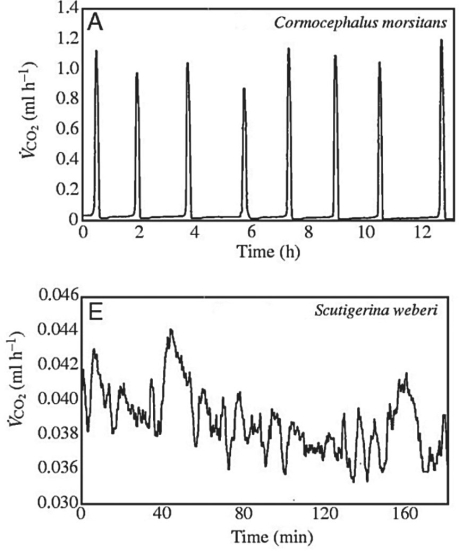Multiple Choice
Use the following information when answering the corresponding questions) .
Many terrestrial arthropods exchange gases with their environments by using tracheae, tubes that lead from openings called spiracles) in the animal's exoskeleton or cuticle directly to the animal's tissues. Some arthropods can control whether their spir opened or closed; opening the spiracles allows the carbon dioxide produced in the tissues to travel down the tracheae and be released outside the animal. Klok et al. measured the carbon dioxide emitted over time represented by VCO2) by several species of centipedes. Figure 31.2 presents graphs of their results for two species, Cormocephalus morsitans and Scutigerina weberi. C. J. Klok, R. D. Mercer, and S. L. Chown. 2002. Discontinuous gas- exchange in centipedes and its convergent evolution in tracheated arthropods.  Figure 31.2
Figure 31.2
-Look at the graph for Scutigerina weberi note the scale of the y- axis) in Figure 31.2. What is the best interpretation of these results?
A) The centipede had its spiracles open when CO2 emission peaked and closed when CO2 emission was low.
B) The centipede had its spiracles closed the entire time.
C) The centipede had its spiracles closed when CO2 emission peaked and open when CO2 emission was low.
D) The centipede had its spiracles open the entire time.
Correct Answer:

Verified
Correct Answer:
Verified
Q1: Adaptations to terrestrial environments evolved independently in
Q2: Of what advantage is a large surface-
Q3: Which of these mollusc features substitutes for
Q4: What would be the most direct effect
Q5: Among protostomes, which morphological trait has shown
Q7: What do all the Lophotrochozoa phyla discussed
Q8: Nematodes and arthropods both<br>A) are suspension feeders.<br>B)
Q9: All arthropods<br>1) undergo complete metamorphosis.<br>2) have jointed
Q10: Upon close inspection of movement in annelids
Q11: What would be the best anatomical feature